One of America’s most festive neighborhoods this time of year is the Georgetown section of Washington, D.C.
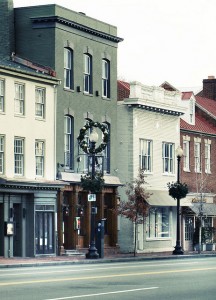
Georgetown doesn’t go crazy at the holidays. Things are predictably tasteful. (bubbo-tubbo, Flickr Creative Commons)
It’s a swanky place, full of well-kept homes, chi-chi shops and restaurants, private schools and academies, and historic churches and cemeteries, as well as a prestigious, 221-year-old Roman Catholic university that carries its name.
The “D.C.” portion of Washington’s name stands for “District of Columbia,” of which Georgetown used to be an independent part. In 1787, the congress of the new United States of America, meeting in Philadelphia, decided to establish a new capital city, and a perfect diamond-shaped one — the District of Columbia — was carved out of land taken from Maryland to the north of the Potomac River and Virginia to the south.
Within it, a whole new city, Washington, named for President George Washington, was created out of mostly brambles and bogs.
And this new District of Columbia included two existing Potomac River port cities: Georgetown from Maryland and Alexandria from Virginia.
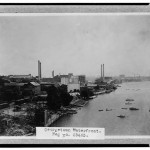
Georgetown harbor in 1910 looks grimy and industrial. There’s no sign of classy stores or townhomes, that’s for sure. (Library of Congress)
Alexandria and the rest of the portion below the Potomac were eventually given back to Virginia. But Georgetown — named for King George the Second of England 25 years before the American Revolution — stayed and was absorbed into the City of Washington in 1871.
These days, Georgetown is somewhat isolated, socially as well as geographically. Much of Washington is poor. Georgetown is affluent. The remainder of town is overwhelmingly black. Georgetown is largely white. A big park and Georgetown University separate much of it from the rest of the city.
Even Washington’s subway system – first laid out in the 1970s – bypasses the tony enclave, meaning the only ways into Georgetown are on foot, or by bike, bus, or car.
(There’s some debate over exactly why the subway never came to Georgetown. Some insist that influential, upper-crust residents, fearful that the subway would bring undesirable elements into the neighborhood, successfully opposed Metro’s construction plans. But others suggest a more mundane reason: that Metro engineers decided it would be impractical to locate a station in Georgetown because of its steep perch above the Potomac River —far, far above any subway line that would be dug into Virginia.)
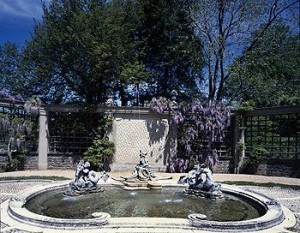
Our church sat a block or so from the famous Dumbarton Oaks, a famous federal-style mansion and garden. (Carol M. Highsmith)
From our home in the Maryland suburbs, Carol and I used to head to Georgetown each Sunday to an old Methodist church whose congregation had been gathering since 1772 and whose building has been in use for 160 years.
Well, to be precise, the original congregation wasn’t still gathering. Those who were were a rather liberal crowd that often clashed with the church’s, shall I say, “traditional?” neighbors. There’s a perceptible haughtiness among Georgetowners, owing, in part, to the wealth it takes to buy and maintain one of the community’s tidy homes, where the median cost of even a small place bumps against half a million dollars.
I say “small place” because narrow houses and townhomes are the rule, though there’s a sprinkling of mansions, including a few that house foreign embassies.
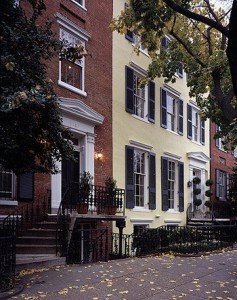
Georgetown is loaded with row houses of the elegant sort. Most have every amenity — except garages. (Carol M. Highsmith)
And whatever your Georgetown house is like, you have “arrived” if it includes an off-street place to park your BMW.
Despite its pedigree, Georgetown hasn’t always been snooty. During the Gilded Age of the late 1800s, many people with money and a yen for larger lots moved to the Dupont Circle area and on out Massachusetts Avenue, where they built impressive Victorian homes. A line of them later became Washington’s “Embassy Row.”
In photos from the early 20th century, parts of Georgetown even look slum-ridden. But gentrification would return with a flourish when a wave of wealthy, well-educated folks — including congressman — and future senator and president — John F. Kennedy and his family moved in after World War II.
An aggressive Citizens Association of Georgetown, formed about this time, made it a point to preserve neighborhood prestige thereafter.
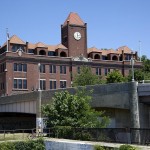
The old “end of the line” trolley barn, a Georgetown landmark just across Key Bridge from Virginia, is now owned and used by Georgetown University’s Public Policy Institute. (Carol M. Highsmith)
Old structures that had turned shabby, including a streetcar barn and smoky incinerator, were “redeveloped” into offices or condominiums. Georgetown’s caché grew to the point that today, places on the fringe have adopted names such as “Georgetown Heights.”
If you venture to the heart of Georgetown, at the meeting point of Wisconsin Avenue, which winds all the way north into Maryland, and M Street, which is a westward extension of Pennsylvania Avenue past the White House, you will find — in addition to tasteful homes and specialty shops — a lively night scene, a simple 1765 stone house that’s the oldest standing building in Washington, and tasteful Christmas decorations along its narrow streets.
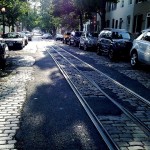
Substitute antique automobiles for the modern ones shown, and this could be Georgetown, circa 1930. (brownpau, Flickr Creative Commons)
Old Belgian cobblestones and streetcar track remnants, too, can still be found on two of those streets.
Don’t be surprised if you run into a Supreme Court justice, a member of Congress, or a media mogul hanging those decorations or out walking the dog.
A long, but I hope interesting, final note about this part of our nation’s capital:.
Georgetown began as a small but thriving tobacco port, to which Maryland farmers brought their crop for shipment down the Potomac River to the Chesapeake Bay. But by 1820, the Potomac had clogged with silt so badly that Georgetown couldn’t be reached. And downstream to boot, a bridge had been built over to the bigger port of Alexandria. So the tobacco farmers lugged their haul there instead.
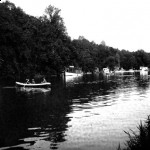
Pleasure boats as well as freight-hauling canal boats ply the C&O Canal in this photo, taken in 1915. (Library of Congress)
But boom times returned to Georgetown briefly with the construction of the ambitious Chesapeake & Ohio Canal, which ran upstream alongside the Potomac, 296 kilometers (184 miles) to Cumberland in Western Maryland. The “Ohio” part of the C&O Canal’s name traced to the original plan to link Georgetown with the bustling industrial town of Pittsburgh, Pennsylvania, on the Ohio River. But the canal company ran out of money when it reached Cumberland.
The canal was needed because the Potomac itself is bedeviled by nasty rocks, rapids, and waterfalls. In the summertime, parts of it nearly run dry.
So in the heady days when the Erie Canal up in New York state was practically printing money as a freight and pleasure-boat route, an investment company built the C&O, including brick aqueducts along the way to bring water from the river, and a series of 74 stone locks. These were necessary because the terrain rises 185 meters or so. They lifted boats about three meters at a time as mules pulled them along a towpath up to Cumberland.
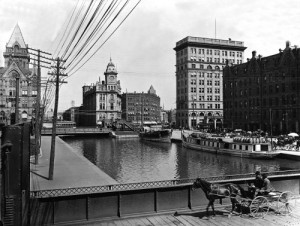
A horsecart passes over the much more successful Erie Canal in Syracuse, New York, about 1900. (Library of Congress)
The C&O operated for 74 years. At its peak in the 1870s, more than 500 long, narrow boats at a time carried cargo up and down its length. Each had a rudder to keep the boats apart as they passed each other. They had no motor whatsoever.
Each boat contained a captain’s cabin, a mule stable, a hay house where grain was kept for the animals, sizable cargo holds, and, sometimes, passenger quarters.
Much of the canal was lined with thick clay. Workers spread the gloppy clay the way you’d smear frosting on a cake in order to keep the water in the canal ditch from seeping through the porous dirt walls.
There wasn’t much danger of accidents. The boats moved only about five or six km an hour, so collisions were hardly catastrophic. Still, old photos show children on deck, strapped in harnesses to keep them from falling overboard.
There was one sad incident: One day, a boat was approaching a Georgetown factory from which an exhaust pipe periodically belched boiling-hot steam. Just as a boat passed, steam blew into a cabin, scalding some children to death.
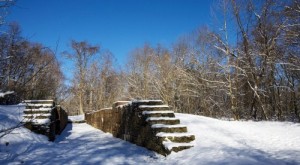
Some parts of the C&O Canal have disappeared. This is an old staircase that once led up to the towpath. (Carol M. Highsmith)
A much lighter moment was a famous standoff at Paw-Paw Tunnel, the canal’s only covered passageway, not far from Cumberland. It was wide enough for just one boat. But on this occasion, two boats entered the bottleneck from opposite directions, and neither captain would back off. Finally one of the canal company’s superintendents showed up and lit a shock of green corn that literally smoked one of the boats out of the tunnel.
The C&O was a failure almost from the start. The very day that ground was broken — July 4, 1828 — the nation’s first railroad, the Baltimore and Ohio, got started along a parallel route, also heading for Pittsburgh. It got to Cumberland eight years ahead of the canal, and faster railroads that ran in all seasons soon killed any hope of fat profits for all of America’s canals. The C&O hung on, carrying mainly coal to Washington from the Maryland mountains, because its rates were cheaper than the railroads’.
Most of the ditch and its adjacent towpath were saved in the 1950s, thanks to an outdoor enthusiast with clout: U.S. Supreme Court Justice William O. Douglas — a Georgetown University graduate and onetime G.U. law professor — took journalists on hikes along the towpath to stave off the federal government’s plan to turn large parts of the C&O into a paved highway.
The old C&O still carries water, and in two functioning sections the National Park Service runs replica boats — helmed by attendants in period costume and pulled by mules as in times gone by — on hour-long round trips. One departs from the heart of Georgetown.
The towpath along the rest of the canal makes a fine bike and hiking path. And if the weather in Washington continues as bitter cold as it has been this week, you might look down into the Georgetown lock and spot an ice skater or two taking advantage of the frozen few centimeters of water that managed to burble up or seep in to the otherwise drained Chesapeake & Ohio Canal.
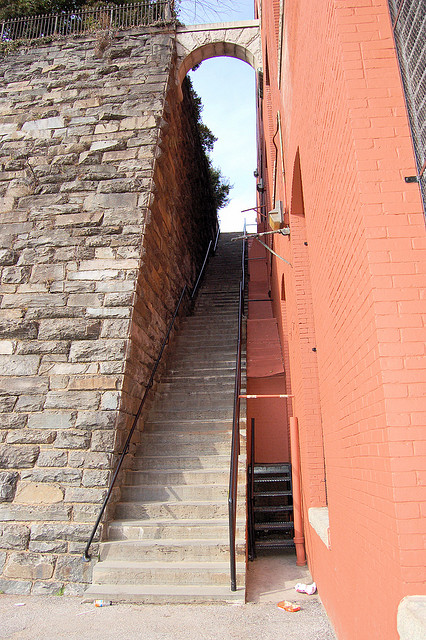
These are the five-story-high “Exorcist steps” down to M Street. In the chilling movie of that name, a priest rids himself of the devil by hurling to his death down these steps. (dameetch, Flickr Creative Commons)
Ted's Wild Words
These are a few words from this posting that you may not know. Each time, I'll tell you a little about them and also place them into a cumulative archive of "Ted's Wild Words" in the right-hand column of the home page. Just click on it there, and if there's another word that you'd like me to explain, just ask!
Glop. A shapeless, gooey, gummy substance. Sometimes you spread it; sometimes you step in it.
Mogul. A wealthy business leader. A “big shot.”
To boot. Something additional, as in “We saw a show and got a discount to boot.” One story pegs the term’s origin to the Old American West. There, it is said, when a trade of goods was agreed upon but the value of one item was greater than the other, the owner of the more valuable item would throw in a little cash to even things up. The other person could take the money right “to boot” — slipping it into his cowboy boot.

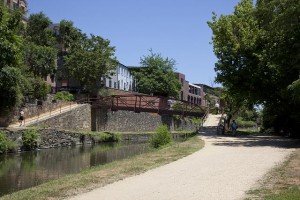

One response to “Lordly Georgetown”
I’ve been looking for and seek for facts regarding this for really some time now. Thanks for the very useful insight.